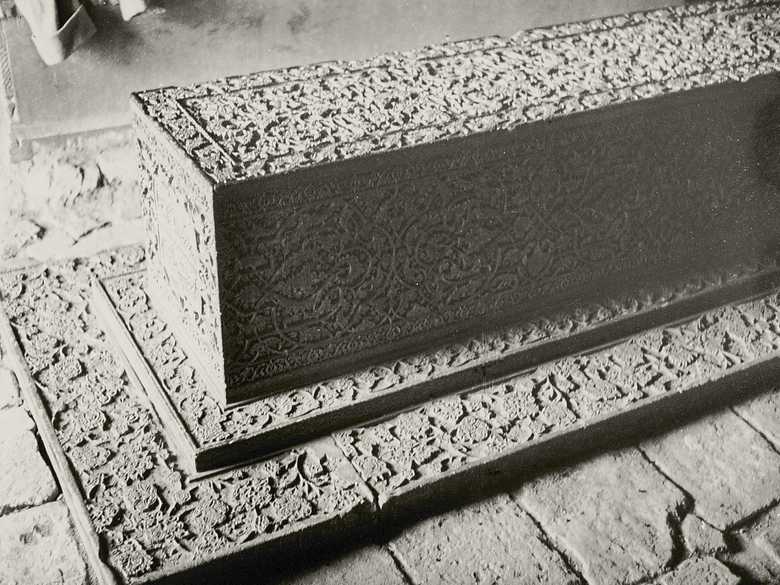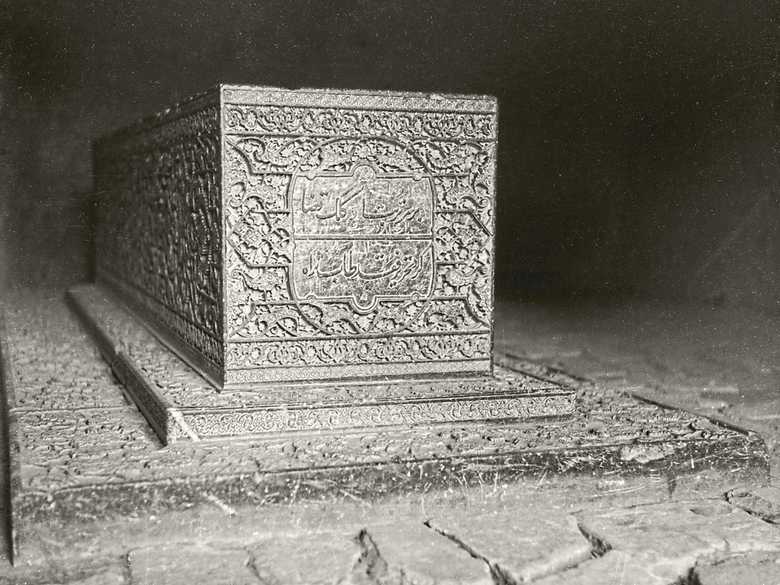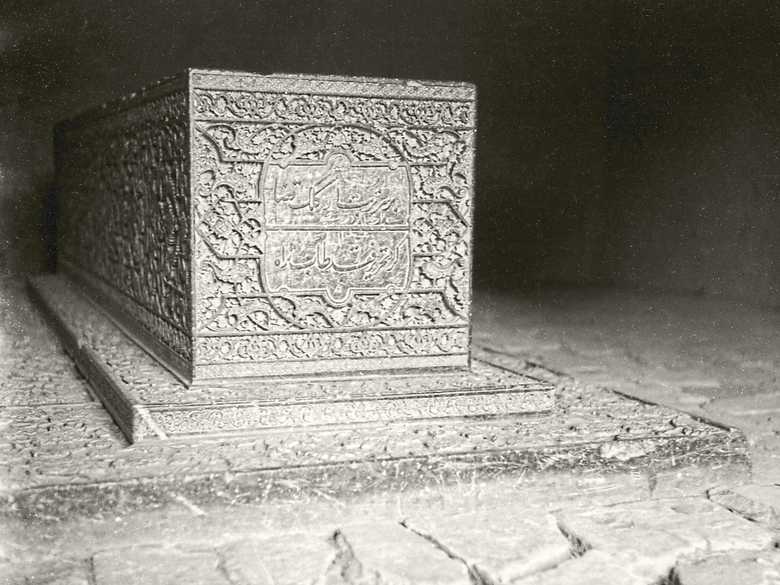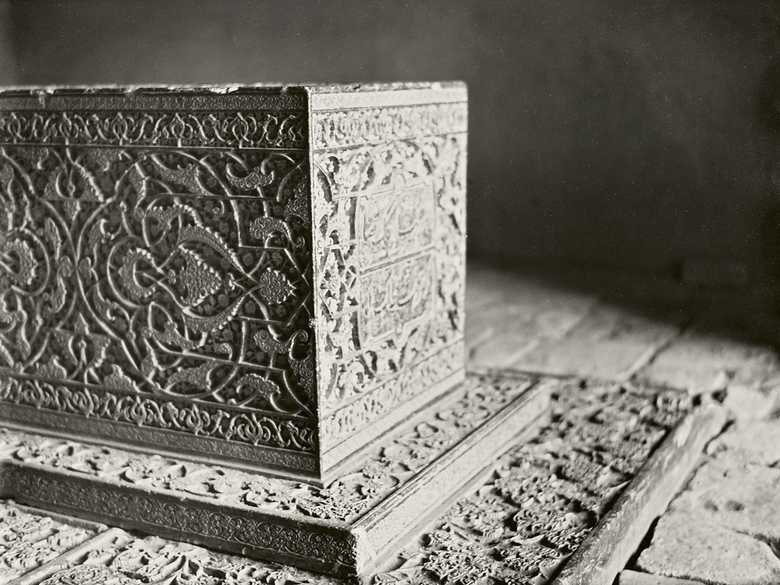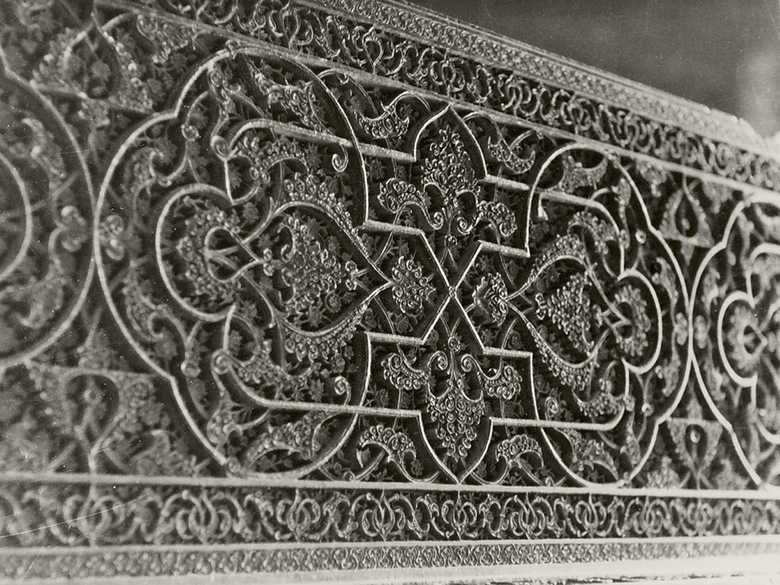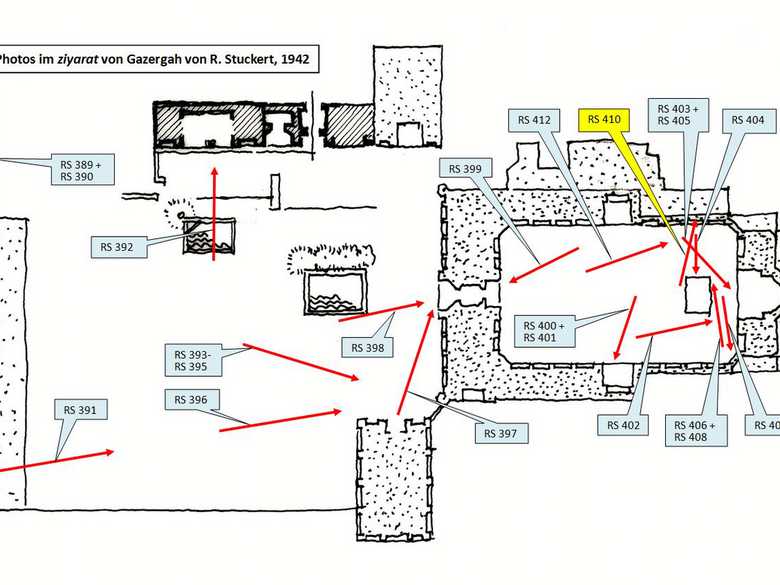RS 410 — Der schwarze Kenotaph haft kalam
|RS 410-1|
Detail-Aufnahmen des berühmten schwarzen Kenotaphs haft kalam.
- R. Stuckert (1994): Erinnerungen an Afghanistan, S. 67: „Im inneren Hof stehen verschiedene Grabstelen in ausserordentlicher Steinhauerarbeit. Berühmt ist der schwarze Sarkophag haft Kalam (sieben Feder[-Schriften]), der mit Ornamenten in verschiedenen Ebenen überzogen ist.“
- L. Golombek (1969): The Timurid Shrine at Gazur Gah, S. 43: “[…] contains the famous cenotaph of carved black stone, known as the ‘Haft-qalam’ […]. It is one of the most intricate and delicate carvings ever created by the Iranian world. Few visitors have failed to marvel at the workmanship of this stone, with its floral and scroll designs, carved deeply into the stone, one layer superimposed on the other through the technique of undercutting. It is dated by abjad-reckoning to the year 902 / 1496–97. The thesis that it was originally intended for the tomb of Shah Gharib Mirza and was removed from the Madrasah of Sultan Husayn in the Musalla of Herat is put forward by Saljuqi. […] This particular stone has been moved around several times, for photographs taken only thirty years ago show it to be in one of the north additions. […]”
- N. H. Dupree (1977): An Historical Guide To Afghanistan, S. 255: “[…] A most remarkable sarcophagus, called the Haft Qalam (Seven Pens), is fashioned of black marble and dates from the reign of Sultan Husain Baiqara (1468–1506). The Haft Qalam is kept in a small locked chamber in the north wall. […]”
- D. Brandenburg (1977): Herat, S. 43: „[…] Der kostbarste aller Grabsteine in schwarzem Marmor heisst Haft Qalam, ‚Sieben Federn‘. Er wird in einer Kammer gehütet, deren Eingang hinter dem Grab des Emirs Dost Mohammad […] zu finden ist. Man sagt, der unbekannte Künstler habe diesen Stein für den Fürsten Husain Baiqara selbst angefertigt. […]“
- R. Samizay (1981): Islamic Architecture in Herat, S. 74: “Another well-known tombstone in Gazargah is the Haft Kalam. Haft Kalam literary means 'seven strokes', and it is called so because it was carved in seven stages. The first is shaping the stone, the second is levelling and smoothing, the third is hollowing inside, the fourth, fifth and sixth are applying decorative motifs, and the seventh is carving the inscriptions. The result is a stone of superb three-dimensional effect with floral designs and inscriptions applied at varying levels. The inscriptions are in Kufic, Suls and Nasta'liq. The mason who carved this stone is believed to have been Ustad Shamsuddin who lived during the time of Sultan Hussein Baiqara and took seven years to complete the job. Although the stone was meant to be for Baiqara's tomb, upon its completion Baiqara's son died and the Sultan ordered that the stone be placed on his son's grave. There is a similar stone placed on Baiqara's grave in the Musalla of Herat.”
- B. Wannell; W. Amini (2013): Herat Elite Burials, S. 66–69:
“Shah Gharib Mirza, 902 HQ / 1497 AD (ABJAD)”
S. 66: “Shah Gharib Mirza predeceased his father, Sultan Husain Bayqara. […] The tombstone is known as haft qalam, seven chisels, due to its exceptionally fine carving. […] The prince died childless and was buried in his father’s madrasa-mausoleum near the musalla, where the Sultan himself would be buried nine years later. […] The prince’s cenotaph was later transferred to Gazur Gah probably during the Chingizi period, and was not re-carved.”
S. 67–69: Weitere Ansichten desselben Kenotaphs.
Image No.
RS 410
Collection
Rudolf Stuckert 1940-1946
Series
RS 387-412, Herat, Gazergah
Format
Neuer Abzug (1989) 140/190 mm
Quality
sehr gut, leicht verkantet
Place, date
Herat, 1942
Descriptors
Latitude / Longitude34.375000 / 62.240970
Google Mapshttps://maps.google.com
Zoom Earthhttps://zoom.earth
You know more about this picture?


